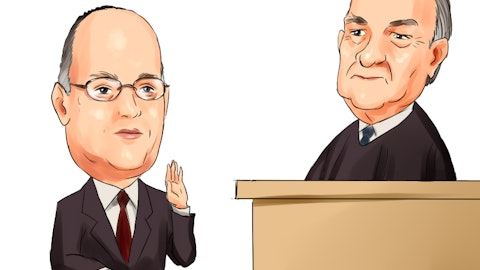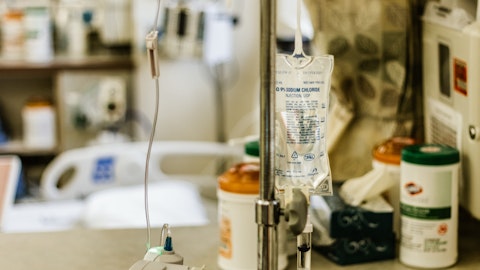Jennifer Kim: If I could sneak one more in just on the R&D expenses. I know in the 10-Q, it’s a manufacturing — lower costs around manufacturing was the driver. But I’m wondering, how do you think about the move in the R&D expenses in your mid to late-stage programs? Because I thought it took a bit down quarter-over-quarter for [indiscernible] like sort of across the line on the external expenses. Do you expect it to sort of stay where it is? Or how should we think about that over the next year or so?
Sara Bonstein: Yes. Thanks, Jennifer, for the question. We obviously haven’t provided forward-looking guidance, but what I can say is we continue to have investment in research and development to support all of our programs. Obviously, our early-stage efforts are less than 20% as we’ve committed to our ARIKAYCE TPIP and brensocatib are 80% plus from an overall investment perspective. The ARISE and ENCORE programs are obviously ongoing. ASPEN is ongoing data readout Q2 of next year and then TPIP, the Phase II is ongoing. And then obviously, the start-up costs for some of the launch readiness activities. Manufacturing costs tend to be lumpy in nature. So I wouldn’t read more into manufacturing costs are lumpy in nature.
Operator: And your next question comes from Vamil Divan with Guggenheim Securities.
Vamil Divan: Maybe first just on the TPIP side again. The one question I have about — so it looks like about 80% of — sorry, yes, 80% patients are getting to the highest dose across the 2 different groups. I’m curious sort of what’s preventing the 20% or so that are not getting there? Is it just cough or something else probably there’s no throat irritation or pain so assume it’s not that. And then I’m just — the question we’re getting in from some investors. I’m curious. You talked about this a little bit, but what would you say is sort of reasonable placebo responses that we should expect in PH and PH-ILB. Do you just — I think if you try sort of sort out, obviously, we’re still going to get more data here as we go forward. But from what we have right now, trying to sort of how the placebo group may have performed would be helpful. You can give any insights.
William Lewis: So I think what I would say about the trial is that so far it is — both trials are progressing very well. The perception we’re trying to convey from the steering committee and from the KOLs who see these data is incredibly encouraging. And some have even used the phrase, which I appreciated, a category killer, for the description of this drug. So I am incredibly encouraged by what we’ve seen. It is early in the trials, and so we want to always footnote that aspect of what we’re seeing. The 20% that are not getting to the max tolerated dose, I don’t want you to walk away and think that there are people who are having significant adverse events here. Some aren’t going higher for any number of reasons. It’s not that many, but those who are, are still getting to substantial levels — so they may not make it to 640 in the 5-week time, which is the cutoff time frame, but they are still getting to high levels.
And so that are, in some cases, significantly, still significantly above where the best available Tyvaso dry powder can achieve. So from that perspective, we feel really good about every aspect of this trial. I mean on the extreme side, I would say that when you think about PVR, the normal level is around 2 Wood units. And we are seeing some patients who are approaching that level. So that — if you think about the way this drug works, 24 hours of coverage with a single administration, this is like a continuous infusion to the lung of treprostinil through inhalation. And that is not something that is currently possible. So if this continues to read out the way it is, I think there’s every reason to believe that this is going to be a game-changing compound.
I don’t know if I answered the other aspect of your question.
Sara Bonstein: Placebo response.
William Lewis: Placebo response, yes. I’m hesitant to give a background information on other meds. I know that public — that information is publicly available. So perhaps we can help you dig that up at sidebar and get that around.
Operator: And your next question comes from the line of Ritu Baral with TD Cowen.
Ritu Baral: I wanted to — for my first question, pivot to ASPEN a little bit. Will, can you comment a little bit about how you’re seeing the blinded data come in with respect [indiscernible] baseline event rates, exacerbation rates and also the blended event rate for that trial? And how should we be thinking about the powering or any additional detail on powering an MCID that you could give us after your discussions at ERS?
William Lewis: Yes. So what I would say about the ASPEN trial is that it is continuing exactly as we would want it to. We start with the awareness that the inbound patients fit the profile of WILLOW almost perfectly. And so that is an encouraging base of information. As we released once before, the event rate hasn’t really changed. So there’s no real reason to update it. And so — I mean, it will move around a little bit, but the vast majority of this trial is now completed. And so what I would also say is that along the way, we are cleaning the data as we go. So we are in a very strong position with regard to the completion of the trial and being able to move to the production of the data and ultimately into what we hope will be a filing.
So I don’t know if there’s a lot more to update in terms of blended blinded data we’re seeing, except to say that the elements I look for are remaining consistent with what we’ve publicly stated before, and we continue to hear the anecdotes from physicians that they are seeing patients with notable improvements, although once again, we don’t know whether they’re on placebo or treatment. From a powering point of view, this study was powered for at least 90% to show a 30% reduction. In Phase II, we were 80% powered to show a 40% reduction, and we were stat-sig. So I think we are well powered. We have conservative assumptions behind event rates. The event rates we’re seeing are consistent with WILLOW. I mean this study, it may be big multiples of the size of WILLOW and certainly bigger than anything else that’s ever been done in the space before.
But we like to say internally that this trial design will not fail the drug. It is always possible that the drug may have some unexpected results, but I do not think that we will be lacking for powering, and I expect that to convey a clear message at the time we unblind.
Ritu Baral: And then moving to TPIP and its tolerability. You mentioned that most of the cough was mild. Can you comment on the rate of moderate cough? Did you see any serious cough or severe cough?
William Lewis: Actually, cough is one of the points of great strength of this compound. And we did a ton of preclinical work on this. One of our physicians who is an expert in this area, Dick Chapman, really did some pioneering work for us and using gold standard models established that this compound was really able to be used without a lot of that sort of side effect profile. There are patients who experience cough, particularly with PH-ILD because cough is a feature of the disease. And anytime you’re using a dry powder in that setting, you’re going to expect some cough. But I don’t — again, the message today should be heard that we’re not seeing anything out of the ordinary for PAH or PH-ILD patients who are treated receiving treprostinil in other forms and in many ways, ours, to our mind, materially better.
Operator: And your next question comes from the line of Jeff Hung with Morgan Stanley.
Jeff Hung: This quarter, you reiterated your guidance, which at the midpoint would suggest that 4Q could be flat. Last year’s fourth quarter ended up declining sequentially. So can you just talk about the factors that we should be keeping in mind for the rest of this year? And then how they compare to those from last year? And then I have a follow-up.
Sara Bonstein: Yes. Sure. Happy to address that, Jeff. Thanks for the question. So we were really encouraged by the performance of ARIKAYCE this quarter, second sequential quarter of substantial growth guidance, obviously tracks [indiscernible] over 20% growth year-over-year with us now getting to our 5th year anniversary. So again, really encouraged by the performance. Japan is, we have always said, is the second half of the year story. That growth started a little bit earlier than we expected, yet we still saw sequential growth this quarter in Japan, and we continue to have expectations for Japan to continue to be strong. Q4, as you can look at historical performance, Q4 in the U.S., gross to net usually is a little bit higher. So just some kind of seasonality there, if you just look at historical performance. But overall, we’re really proud of the performance that ARIKAYCE has been able to do now entering its sixth year in the most mature territory.


